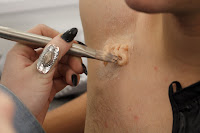Overall I have enjoyed this
project and learnt a lot about a world I knew nothing about. I found that the
health and safety regulations were a lot more crucial to this part of the
industry, not only applying to the client as they usually do but also to myself
as the make-up artist. For example wearing facemasks and gloves when dealing
with the different chemicals such as the Plastil Gels and the fixing and
petrolease sprays.
One of the things I enjoyed
most about this project was experimenting with completely new materials, for
example using clay to mould the prosthetic, and using something as simplistic
as the netting fruit comes in to create a scaled effect on the face for my
human-hybrid.
However despite learning so
much and having the ability to be so creative, which was a massive bonus and a
lot of fun for me, I feel that this unit has been the biggest struggle for me
since starting the course last year. I always had my heart set on becoming a
special effects make-up artist for films and television in the future so was
very excited when I got on to this option. Unfortunately I have really
struggled with successfully creating prosthetic pieces to a high standard. I
had to make my wound 3 times before I got a piece I was happy with and this
resulted in me being very short for time and very stressed. I also feel that,
although I am happy with how my final shots came out for my hybrid project, the
prosthetic is quite thick and it is quite obvious it is not part of the rest of
the skin. Therefore although I feel that my final shots are my best effort and
I put a lot in to them, they are not of a very high standard. This has led me
to feel I am going to have to rethink my aims and goals for the future and
possibly look in to going down a different path within the make-up industry.






















































